-
Countries
-
Data and Analysis
-
Special Focus
-
Crisis Responses
Return migration
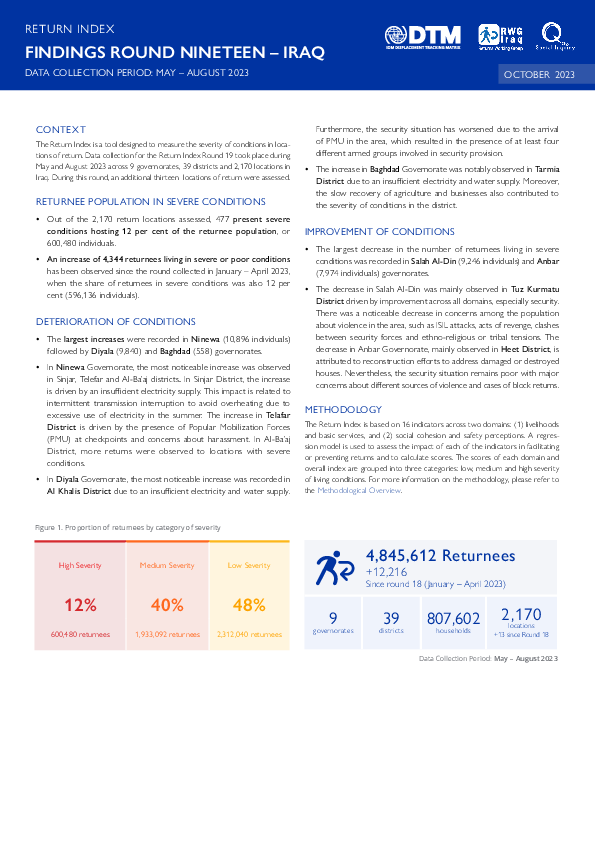
Contact
DTM Iraq, IraqDTM@iom.int
Language
English
Location
Iraq
Period Covered
May 01 2023
Aug 31 2023
Activity
- Survey
- Return Intention
- Mobility Tracking
- Baseline Assessment
The Return Index is a tool designed to measure the severity of conditions in locations of return. Data collection for the Return Index Round 19 took place during May and August 2023 across 9 governorates, 39 districts and 2,170 locations in Iraq. During this round, an additional thirteen locations of return were assessed.
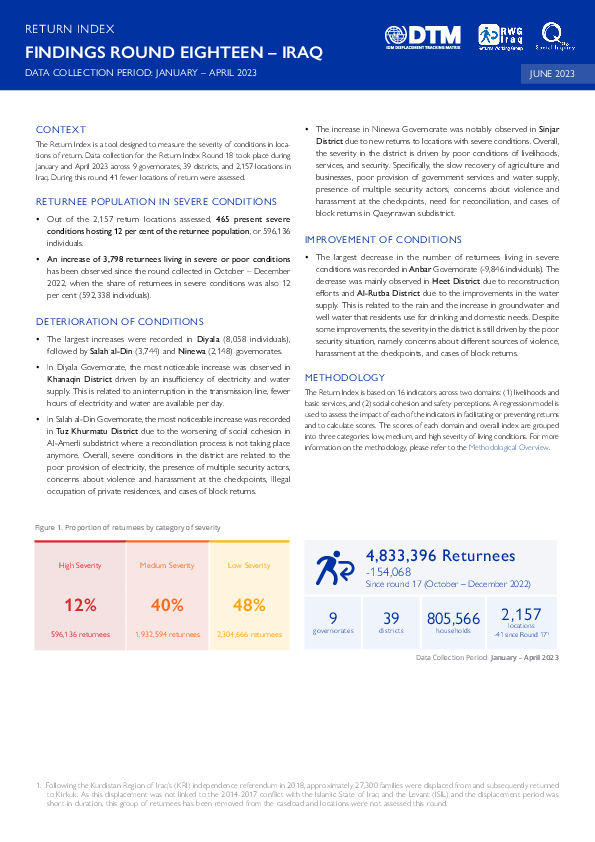
Contact
DTM Iraq, IraqDTM@iom.int
Language
English
Location
Iraq
Period Covered
Jan 01 2023
Apr 30 2023
Activity
- Survey
- Return Intention
- Mobility Tracking
- Baseline Assessment
The Return Index is a tool designed to measure the severity of conditions in locations of return. Data collection for the Return Index Round 18 took place during January and April 2023 across 9 governorates, 39 districts, and 2,157 locations in Iraq. During this round, 41 fewer locations of return were assessed.
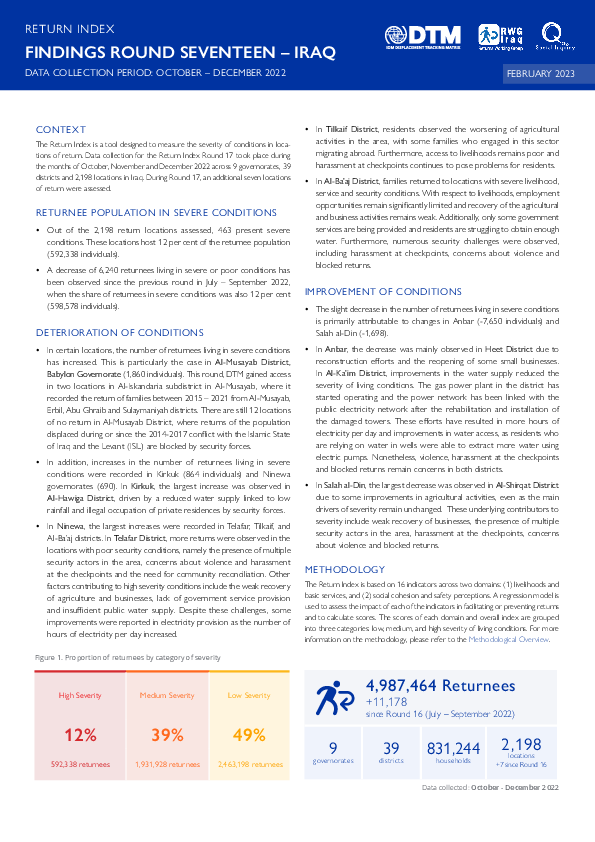
Contact
DTM Iraq, IraqDTM@iom.int
Language
English
Location
Iraq
Period Covered
Oct 01 2022
Dec 31 2022
Activity
- Survey
- Return Intention
- Mobility Tracking
- Baseline Assessment
The Return Index is a tool designed to measure the severity of conditions in locations of return. Data collection for the Return Index Round 17 took place during the months of October, November and December 2022 across 9 governorates, 39 districts and 2,198 locations in Iraq. During Round 17, an additional seven locations of return were assessed.
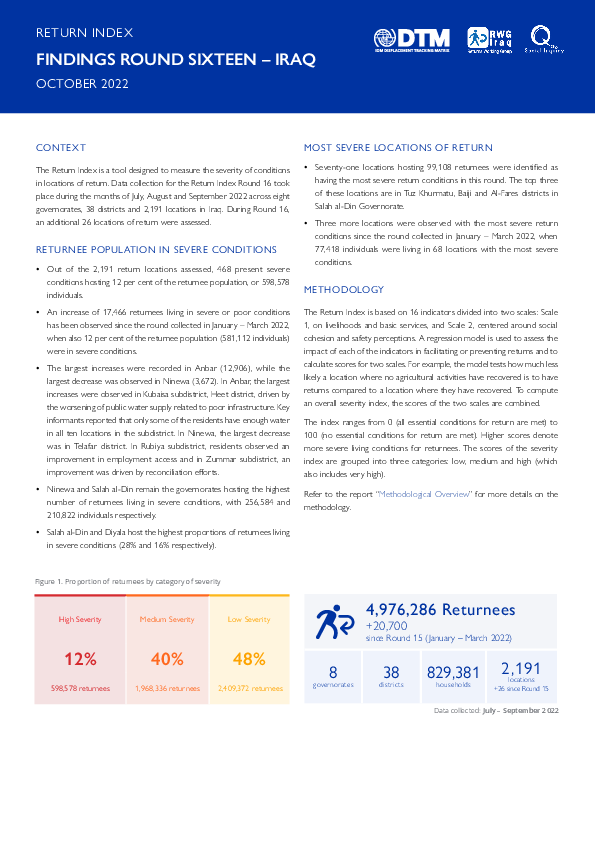
Contact
DTM Iraq, IraqDTM@iom.int
Language
English
Location
Iraq
Period Covered
Jul 01 2022
Sep 30 2022
Activity
- Survey
- Return Intention
- Mobility Tracking
- Baseline Assessment
The Return Index is a tool designed to measure the severity of conditions in locations of return. Data collection for the Return Index Round 16 took place during the months of July, August and September 2022 across eight governorates, 38 districts and 2,191 locations in Iraq. During Round 16, an additional 26 locations of return were assessed.
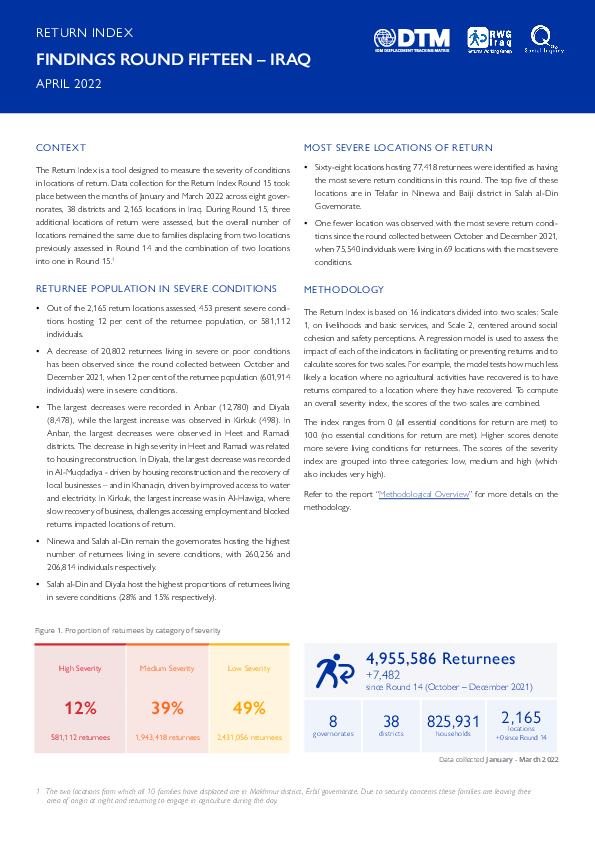
Contact
DTM Iraq, IraqDTM@iom.int
Language
English
Location
Iraq
Period Covered
Jan 01 2022
Mar 31 2022
Activity
- Survey
- Return Intention
- Mobility Tracking
- Baseline Assessment
The Return Index is a tool designed to measure the severity of conditions in locations of return. Data collection for the Return Index Round 15 took place between the months of January and March 2022 across eight governorates, 38 districts and 2,165 locations in Iraq. During Round 15, three additional locations of return were assessed, but the overall number of locations remained the same due to families displacing from two locations previously assessed in Round 14 and the combination of two locations into one in Round 15.
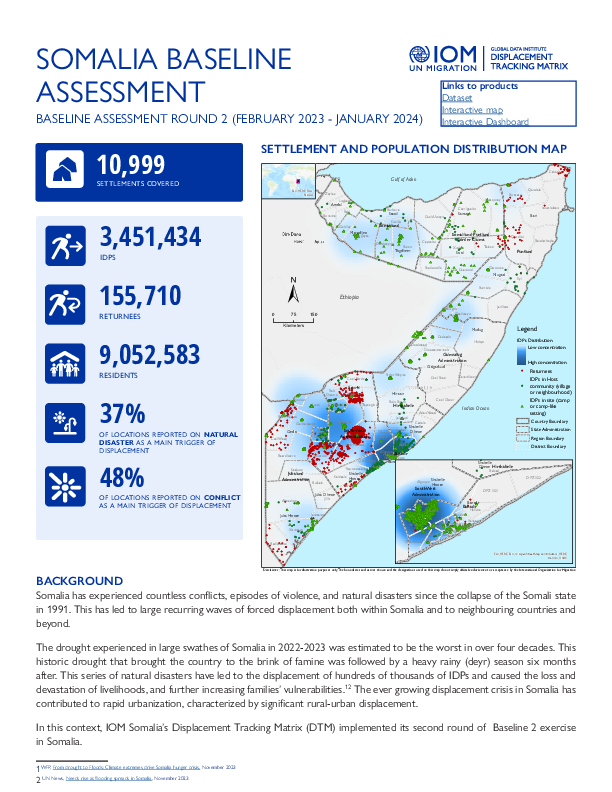
Contact
DTM Somalia, IOMSomaliaDTM@iom.int
Language
English
Location
Somalia
Period Covered
Feb 01 2023
Jan 31 2024
Activity
- Mobility Tracking
- Baseline Assessment
Baseline 2, an area-based assessment, is the second step of Mobility Tracking implemented at settlement level and aims to quantify presence of population categories.
As of January 2024, DTM Somalia has mapped around 3,451,434 IDPs, 155,710 returnees and 9,052,583 residents across 17 regions and 10,999 assessed locations. IDPs were present in 45 per cent of locations assessed (4,611 locations) and returnees were present in eleven per cent of assessed locations (1,204 locations)
The results include regions of origins, reasons for displacement and accessibility information, as well as the Operational Zones (OPZ) established by OCHA. These zones are designed to support sub-district response and reporting efforts.

Contact
DTM Europe, DTMMediterranean@iom.int
Language
English
Location
Latvia
Period Covered
Jan 01 2023
Dec 31 2023
Activity
- Survey
- Return Intention
Key Findings
- Top countries of stay: Poland (31%), Russian Federation (20%), Germany (19%), and Czeck Republic (5%).
- Intentions: 49% plan to stay in Ukraine (prospective returnees), 29% going for a short visit, 20% undecided, 2% preferred not to answer.
- Top needs*: general information (83%), food supplies (11%), short-term accommodation (3%), financial support (3%), health services (1%), long-term accommodation (1%).
- Assistance received*: financial support (91%), accommodation (67%), food supplies (60%), personal hygiene and sanitary supplies (30%), clothes & shoes (24%), transportation (21%).
- Destinations in Ukraine: 86% to the same oblast of origin, 14% to a different oblast in Ukraine: Donetska (33%), Kyiv city (15%), Luhanska (12%).
- Transport to Ukraine: minibus (41%), car (27%), foot (23%).
- Travel mode: 68% alone and 32% in group.
*Multiple answers possible

Contact
DTM Europe, DTMMediterranean@iom.int
Language
English
Location
Slovakia
Period Covered
Jan 01 2023
Dec 31 2023
Activity
- Survey
- Return Intention
Key findings
- Top countries of stay: Slovakia (77%), Czechia (3%), Austria (2%), United Kingdom (2%), Ireland (2%), Germany (2%).
- Intentions: 56% going for short visit, 37% plans to stay in Ukraine (prospective returnees), and 7% is undecided.
- Reasons for short visit*: meeting family (46%), seeking healthcare (19%), collecting documents (9%). (*more than one answer possible)
- Reasons for long stay*: returning from a short visit abroad (33%), did shopping abroad (11%), improved situation in place of origin (10%). (*more than one answer possible)
- Destinations in Ukraine: 83% travels to the region of origin, 16% to a different region in Ukraine, and 1% is undecided: Zakarpatska (42%), city of Kyiv (13%), Dnipropetrovska (6%).
- Top needs*: healthcare (22%), medication (13%), financial support (12%), general information (12%), employment support (11%). (*more than one answer possible)
- Households*: 14% travels with at least one infant (0-4 years-old), 56% travels with at least one child (5-17 years-old), 45% are single-headed households, and 14% travels with elderly (60+ years-old). (*more than one answer possible)

Contact
DTM Europe, DTMMediterranean@iom.int
Language
English
Location
Hungary
Period Covered
Jan 01 2023
Dec 31 2023
Activity
- Survey
- Return Intention
- Flow Monitoring
The Crossing Back surveys conducted between January-December 2023 focused on individuals crossing back to Ukraine from or through Hungary, either for the short-term or long-term. For the purpose of the analysis, ‘’short-term visitors’’ are those who intended to spend 0-30 days in Ukraine, while respondents intending to stay for more than one month are labelled as “prospective returnees”.
The analysis of the survey participants’ marital status revealed a diverse range of relationship statuses. In total, over 61 per cent of the surveyed nationals identified as married, while 18 per cent of them reported to be single. Additionally, 12 per cent indicated being in a partnership, six per cent were widowed, and two per cent divorced. In 2023, the highest proportion of men were married (70%), followed by those who were single (17%) and those in partnerships (6%). Among women, a similar trend was recorded, as 59 per cent were married and 19 per cent were single. However, a higher proportion (13%) reported to be in partnerships, surpassing the equivalent figure for men.
Among the 1,253 survey participants, 76 per cent (N=948) were Ukrainian nationals, and 24 per cent (N=305) were Third-Country nationals (TCNs) with residence in Ukraine. The present analysis is derived from the responses of the Ukrainian participants.

Contact
DTM Europe, ROViennaDataResearch-Newsletter@iom.int
Language
English
Location
Republic of Moldova
Period Covered
Feb 01 2023
Jun 30 2023
Activity
- Survey
- Return Intention
The onset of the war in Ukraine has caused substantial displacement of people both within the Republic of Moldova’s borders and throughout the neighbouring region. The refugee situation is coupled with significant movement flows of Moldovan labour migrants returning from abroad, in particular from Ukraine, the Russian Federation, and other neighbouring countries. The effects of the Ukraine crisis, combined with the lingering consequences of the COVID-19 pandemic could potentially change the Republic of Moldova’s migration dynamics, leading to a decrease in emigration and an increase in the number of Moldovan citizens returning home.
This may have severe long term effects on the already strained Moldovan economy hindering its capacity to respond to the humanitarian and economic challenges attendant to the Ukrainian crisis. There are major gaps in data on Moldovan returnees, including information on their socio-economic profiles, needs and vulnerabilities as well as their intentions for their future. To fill those gaps the International Organization for Migration (IOM), as the leading inter-governmental organization promoting humane and orderly migration, has conducted a survey with Moldovan returnees in order to assess how the war in Ukraine has affected them.
Pagination
- Previous page
- Page 4
- Next page
